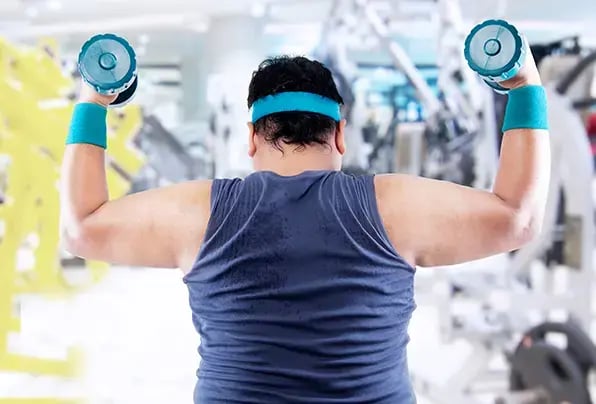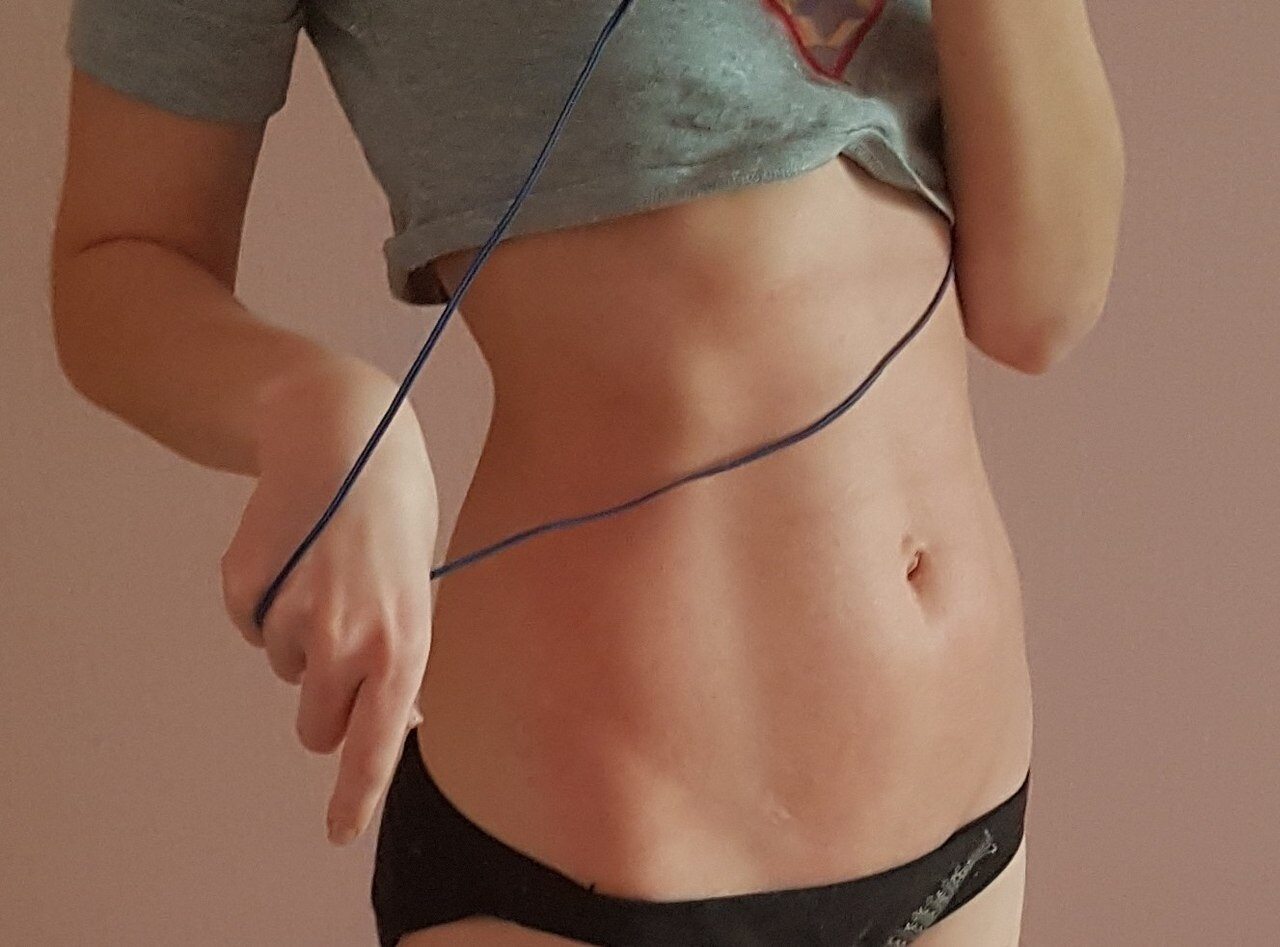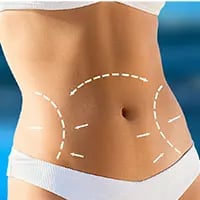What are Love Handles?
What are Love Handles and How to Manage Them?
Love handles, also known as "muffin tops," are a colloquial term used to describe the excess fat deposits that accumulate around the sides of the waist and lower back. They typically extend horizontally from the hips and can be visible when a person wears tight clothing or low-rise pants. Love handles are more common in individuals who have a higher percentage of body fat, particularly around the abdominal area.
These fatty deposits are often stubborn and challenging to eliminate through diet and exercise alone. They can be influenced by various factors, including genetics, hormonal changes, poor diet, sedentary lifestyle, and overall body composition. Targeted exercises that engage the oblique muscles, such as side planks or bicycle crunches, can help strengthen the core and reduce the appearance of love handles, but spot reduction is generally ineffective for fat loss.
Engaging in Activities for Fat

How to Get Rid of Your Love Handles?
Getting rid of love handles involves a combination of a healthy diet, regular exercise, and targeted exercises. Here are some steps you can follow:
1. Calorie deficit: To lose fat from any part of your body, including your love handles, you need to create a calorie deficit. This means consuming fewer calories than you burn. Focus on a balanced diet that includes plenty of fruits, vegetables, lean proteins, and whole grains. Reduce your intake of sugary foods, processed snacks, and high-fat foods.
2. Cardiovascular exercise: Engage in regular cardiovascular exercises to burn calories and promote overall fat loss. Activities like running, cycling, swimming, or dancing are effective for burning excess body fat. Aim for at least 150 minutes of moderate-intensity cardio exercise per week.
3. Strength training: Incorporate strength training exercises into your routine to build lean muscle mass. This helps increase your metabolism and burn more calories throughout the day. Include exercises that target your core, such as planks, Russian twists, and side bends, to help tone and strengthen your abdominal muscles.
4. HIIT workouts: High-Intensity Interval Training (HIIT) can be particularly effective for reducing love handles. These workouts involve short bursts of intense exercise followed by brief recovery periods. HIIT workouts can be done with various exercises like burpees, jumping jacks, mountain climbers, or kettlebell swings.
5. Targeted exercises: While it's not possible to spot-reduce fat from a specific area, targeted exercises can help strengthen and tone the muscles around your love handles. Side planks, bicycle crunches, oblique twists, and standing side bends are some exercises that can help work your oblique muscles.
6. Proper hydration: Drink plenty of water to stay hydrated and support your body's overall functions. Water can help with digestion, keep you feeling full, and contribute to overall weight loss efforts.
7. Consistency and patience: Remember that losing love handles takes time and consistency. Be patient with your progress and maintain a healthy lifestyle in the long term. Aim for gradual, sustainable weight loss rather than resorting to crash diets or extreme measures.
8. Consult a professional: If you're struggling to achieve your desired results or need personalized guidance, consider consulting a registered dietitian or a certified fitness trainer who can provide tailored advice and support.
It's important to note that everyone's body is different, and the rate at which you lose fat may vary. Focus on overall health and well-being rather than solely fixating on one specific area.
Our mission is to create a world where every investment in modern beauty is Worth It.
Let's keep in touch
Get updates of the treatments you are interested
Can You Surgically Remove Love Handles?
The term "love handles" refers to the excess fat that accumulates around the sides of the waist and back. Surgical removal of love handles can be achieved through a procedure called liposuction.
Liposuction is a cosmetic surgical procedure that aims to remove excess fat deposits from specific areas of the body. During the procedure, a plastic surgeon makes small incisions near the targeted area and inserts a thin tube called a cannula. The cannula is used to break up and suction out the unwanted fat.
It's important to note that liposuction is not a weight loss method or a substitute for a healthy lifestyle. It is typically performed on individuals who have already achieved a stable weight through diet and exercise but struggle with localized fat deposits that are resistant to traditional weight loss efforts.
If you are considering liposuction or any other surgical procedure, it is crucial to consult with a qualified plastic surgeon who can assess your specific situation, explain the risks and benefits, and determine if you are a suitable candidate for the procedure.

Types of Liposuction Techniques for Fat
There are several types of liposuction techniques available, each with its own approach and technology. Here are some commonly used types of liposuction:
1. Traditional Liposuction: Also known as suction-assisted liposuction (SAL), this is the traditional method of liposuction. It involves making small incisions in the targeted area and using a cannula (a thin tube) to suction out the fat cells.
2. Tumescent Liposuction: This technique involves injecting a solution of saline, anesthetic (lidocaine), and epinephrine into the treatment area. The solution helps numb the area, shrink blood vessels to minimize bleeding, and swell the fat cells, making them easier to remove.
3. Power-Assisted Liposuction (PAL): PAL utilizes a vibrating cannula to facilitate the breakdown of fat cells and make their removal smoother. The vibrations help the surgeon remove fat with less physical effort, potentially reducing surgical trauma.
4. Ultrasound-Assisted Liposuction (UAL): UAL employs ultrasonic energy to liquefy fat cells before their removal. The surgeon uses a specialized cannula that emits ultrasonic waves to break down the fat, making it easier to suction out. This technique is particularly useful for fibrous or dense fat deposits.
5. Laser-Assisted Liposuction (LAL): Also known as laser lipolysis or laser lipo, this technique uses laser energy to liquefy fat cells. The laser energy is delivered through a small cannula, which melts the fat cells, allowing for their removal. LAL can also stimulate collagen production, which may lead to skin tightening.
6. Water-Assisted Liposuction (WAL): WAL, also called body-jet liposuction, involves the use of a thin fan-shaped water stream to dislodge and remove fat cells. The water jet is introduced through a cannula, and the loosened fat cells are simultaneously suctioned out. This technique is considered gentler than traditional liposuction.
Note that the specific technique used for liposuction will depend on various factors, including the patient's unique needs, the surgeon's expertise, and the area being treated. Consulting with a qualified plastic surgeon will help determine the most suitable type of liposuction for your individual case.
Our mission is to create a world where every investment in modern beauty is Worth It.
Let's keep in touch
Get updates of the treatments you are interested
What are Love Handles and How to Manage Them?
Love handles, also known as "muffin tops," are a colloquial term used to describe the excess fat deposits that accumulate around the sides of the waist and lower back. They typically extend horizontally from the hips and can be visible when a person wears tight clothing or low-rise pants. Love handles are more common in individuals who have a higher percentage of body fat, particularly around the abdominal area.
These fatty deposits are often stubborn and challenging to eliminate through diet and exercise alone. They can be influenced by various factors, including genetics, hormonal changes, poor diet, sedentary lifestyle, and overall body composition. Targeted exercises that engage the oblique muscles, such as side planks or bicycle crunches, can help strengthen the core and reduce the appearance of love handles, but spot reduction is generally ineffective for fat loss.
Engaging in Activities for Fat

How to Get Rid of Your Love Handles?
Getting rid of love handles involves a combination of a healthy diet, regular exercise, and targeted exercises. Here are some steps you can follow:
1. Calorie deficit: To lose fat from any part of your body, including your love handles, you need to create a calorie deficit. This means consuming fewer calories than you burn. Focus on a balanced diet that includes plenty of fruits, vegetables, lean proteins, and whole grains. Reduce your intake of sugary foods, processed snacks, and high-fat foods.
2. Cardiovascular exercise: Engage in regular cardiovascular exercises to burn calories and promote overall fat loss. Activities like running, cycling, swimming, or dancing are effective for burning excess body fat. Aim for at least 150 minutes of moderate-intensity cardio exercise per week.
3. Strength training: Incorporate strength training exercises into your routine to build lean muscle mass. This helps increase your metabolism and burn more calories throughout the day. Include exercises that target your core, such as planks, Russian twists, and side bends, to help tone and strengthen your abdominal muscles.
4. HIIT workouts: High-Intensity Interval Training (HIIT) can be particularly effective for reducing love handles. These workouts involve short bursts of intense exercise followed by brief recovery periods. HIIT workouts can be done with various exercises like burpees, jumping jacks, mountain climbers, or kettlebell swings.
5. Targeted exercises: While it's not possible to spot-reduce fat from a specific area, targeted exercises can help strengthen and tone the muscles around your love handles. Side planks, bicycle crunches, oblique twists, and standing side bends are some exercises that can help work your oblique muscles.
6. Proper hydration: Drink plenty of water to stay hydrated and support your body's overall functions. Water can help with digestion, keep you feeling full, and contribute to overall weight loss efforts.
7. Consistency and patience: Remember that losing love handles takes time and consistency. Be patient with your progress and maintain a healthy lifestyle in the long term. Aim for gradual, sustainable weight loss rather than resorting to crash diets or extreme measures.
8. Consult a professional: If you're struggling to achieve your desired results or need personalized guidance, consider consulting a registered dietitian or a certified fitness trainer who can provide tailored advice and support.
It's important to note that everyone's body is different, and the rate at which you lose fat may vary. Focus on overall health and well-being rather than solely fixating on one specific area.
Our mission is to create a world where every investment in modern beauty is Worth It.
Let's keep in touch
Get updates of the treatments you are interested
Can You Surgically Remove Love Handles?
The term "love handles" refers to the excess fat that accumulates around the sides of the waist and back. Surgical removal of love handles can be achieved through a procedure called liposuction.
Liposuction is a cosmetic surgical procedure that aims to remove excess fat deposits from specific areas of the body. During the procedure, a plastic surgeon makes small incisions near the targeted area and inserts a thin tube called a cannula. The cannula is used to break up and suction out the unwanted fat.
It's important to note that liposuction is not a weight loss method or a substitute for a healthy lifestyle. It is typically performed on individuals who have already achieved a stable weight through diet and exercise but struggle with localized fat deposits that are resistant to traditional weight loss efforts.
If you are considering liposuction or any other surgical procedure, it is crucial to consult with a qualified plastic surgeon who can assess your specific situation, explain the risks and benefits, and determine if you are a suitable candidate for the procedure.

Types of Liposuction Techniques for Fat
There are several types of liposuction techniques available, each with its own approach and technology. Here are some commonly used types of liposuction:
1. Traditional Liposuction: Also known as suction-assisted liposuction (SAL), this is the traditional method of liposuction. It involves making small incisions in the targeted area and using a cannula (a thin tube) to suction out the fat cells.
2. Tumescent Liposuction: This technique involves injecting a solution of saline, anesthetic (lidocaine), and epinephrine into the treatment area. The solution helps numb the area, shrink blood vessels to minimize bleeding, and swell the fat cells, making them easier to remove.
3. Power-Assisted Liposuction (PAL): PAL utilizes a vibrating cannula to facilitate the breakdown of fat cells and make their removal smoother. The vibrations help the surgeon remove fat with less physical effort, potentially reducing surgical trauma.
4. Ultrasound-Assisted Liposuction (UAL): UAL employs ultrasonic energy to liquefy fat cells before their removal. The surgeon uses a specialized cannula that emits ultrasonic waves to break down the fat, making it easier to suction out. This technique is particularly useful for fibrous or dense fat deposits.
5. Laser-Assisted Liposuction (LAL): Also known as laser lipolysis or laser lipo, this technique uses laser energy to liquefy fat cells. The laser energy is delivered through a small cannula, which melts the fat cells, allowing for their removal. LAL can also stimulate collagen production, which may lead to skin tightening.
6. Water-Assisted Liposuction (WAL): WAL, also called body-jet liposuction, involves the use of a thin fan-shaped water stream to dislodge and remove fat cells. The water jet is introduced through a cannula, and the loosened fat cells are simultaneously suctioned out. This technique is considered gentler than traditional liposuction.
Note that the specific technique used for liposuction will depend on various factors, including the patient's unique needs, the surgeon's expertise, and the area being treated. Consulting with a qualified plastic surgeon will help determine the most suitable type of liposuction for your individual case.









